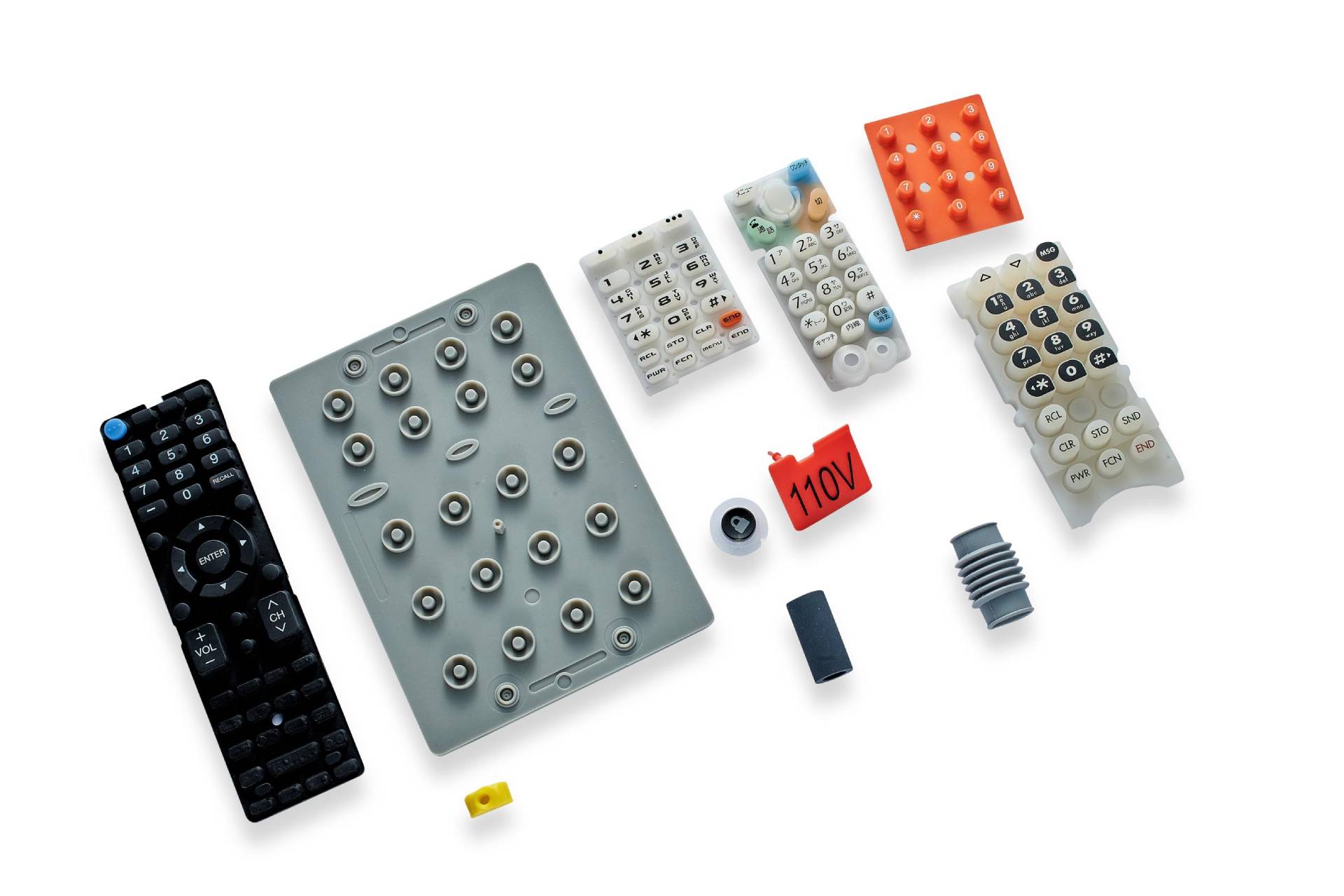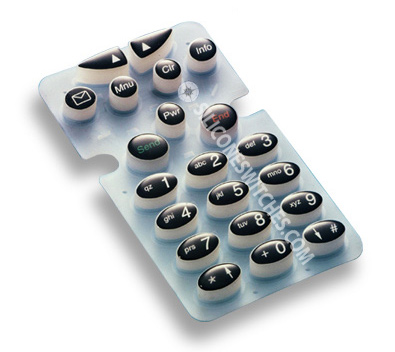Everything engineers should know about designing Rubber Keypads
Exploring the Production Refine Behind Rubber Keypads and Their Importance in Modern Devices
Rubber keypads are crucial in the functionality of contemporary devices. Their production process involves careful option of products and specific methods. Keypads are designed to boost individual interaction while making certain resilience and reliability. Understanding just how these components are made exposes their significance throughout various applications. What aspects add to their efficiency, and exactly how do these elements affect user experience? The responses might improve perceptions of this everyday modern technology.
Overview of Rubber Keypads and Their Applications

Rubber keypads are versatile elements commonly used in numerous digital devices, ranging from consumer electronics to industrial tools. Their design permits for a tactile feedback, making them an excellent option for applications needing individual communication. Commonly located in products such as remote controls, calculators, and clinical devices, rubber keypads help with convenience of use and availability.
In industrial setups, they offer essential functions in machinery and control panels, where sturdiness and resistance to ecological variables are crucial. The non-slip surface enhances grasp, advertising dependability in demanding conditions. Additionally, their lightweight nature and adjustable shapes allow makers to develop tailored options that fit particular needs. With developments in technology, rubber keypads proceed to develop, including attributes like backlighting and boosted sensitivity. In general, their versatility and useful advantages add significantly to the performance of various gadgets throughout multiple industries.
Products Utilized in Rubber Keypad Production
Keypad making counts on a choice of materials that boost both capability and longevity. The key product used in the production of rubber keypads is silicone rubber, recognized for its superb resilience and versatility. This material allows keypads to stand up to duplicated pressing without losing shape or efficiency. Additionally, thermoplastic elastomers (TPE) are commonly utilized as a result of their simplicity of molding and capability to offer a soft-touch feeling.
Tinting agents, such as pigments, are integrated to ensure lively, lasting tones that boost aesthetic charm. In addition, additives like anti-UV agents and flame resistants might be combined right into the rubber to improve weather resistance and safety and security compliance. The option of products straight affects the keypad's tactile action, long life, and overall performance in different tools. Eventually, the mindful choice of these elements is important for the production of high-grade rubber keypads that meet consumer and market needs.
The Layout Refine of Rubber Keypads
When developing rubber keypads, the design procedure plays a necessary role in identifying functionality and individual experience. Designers begin by defining the keypad's planned usage, thinking about elements such as the device it will go along with and the target customer group. This initial stage includes sketching formats that focus on ergonomic facets, making certain the tricks are easily obtainable and properly spaced.
Next, designers concentrate on the responsive comments preferred from the keypads, which influences the selection of products and crucial forms. Prototyping is vital in this stage, permitting developers to test various styles for convenience and responsiveness.
Manufacturing Techniques for Rubber Keypads
The manufacturing procedure for rubber keypads includes a series of accurate strategies that guarantee high quality and capability. Liquid silicone rubber (LSR) is usually made use of due to its sturdiness and adaptability. The process starts with mixing the raw products, including silicone, colorants, and treating agents. This combination is after that injected into mold and mildews made to shape the keypads precisely.
Adhering to injection, the shaped keypads undertake treating, a heating process that strengthens the material (Rubber Keypads). This is usually done in a press, making certain the keypads accomplish the preferred hardness and durability

Top Quality Control Steps in Production
To ensure that rubber keypads satisfy high requirements of top quality and performance, strenuous quality control steps are implemented throughout the production procedure. These steps start with resources inspection, making sure that only the highest-grade elastomers are used. Throughout the manufacturing phase, operators conduct normal checks to keep an eye on specifications such as temperature, stress, and blending times, important for attaining consistent product high quality.
Post-production, each batch of keypads undergoes comprehensive screening, including responsive action evaluations and resilience tests to assess performance under different problems. Visual assessments are likewise performed to recognize any kind of flaws, such as bubbles or disparities in texture. In addition, compliance with sector standards is validated, making certain that the keypads fulfill safety and functionality benchmarks.
The Duty of Innovation in Keypad Growth
Technology plays an essential role in the advancement of rubber keypads by making it possible for sophisticated manufacturing strategies that enhance accuracy and effectiveness. Additionally, cutting-edge product option allows for improved resilience and responsiveness in keypad efficiency. These developments not only improve manufacturing but likewise elevate the overall top quality of the end product.
Advanced Production Techniques
Developments in production methods change the production of rubber keypads, improving both efficiency and precision. Technologies such as shot molding and 3D printing have actually transformed typical procedures, enabling manufacturers to develop intricate styles with reduced waste and enhanced turnaround times. Automation plays an essential duty in this development, simplifying production line and minimizing human mistake. Furthermore, computer-aided style (CAD) software application permits intricate modification, making certain that keypads meet certain user needs. Quality assurance actions have actually additionally progressed, including real-time tracking systems that identify flaws early in the production cycle. These developments not only enhance the resilience and capability of rubber keypads yet also sustain the expanding demand for tailored services in various markets, from consumer electronic devices to automobile applications.
Innovative Material Choice
The development of making strategies has led the way for ingenious material selection in rubber keypad development. Advances in polymer science have presented products that boost longevity, adaptability, and tactile responses. Producers now make use of thermoplastic elastomers (TPE) and silicone substances, which supply remarkable resistance to put on and ecological variables. These products enable the production of keypads that can withstand long term usage while maintaining aesthetic charm. In addition, the integration of finishes and ingredients boosts capability, such as boosting grasp and decreasing friction. The choice of materials is vital, as it directly impacts the efficiency and long life of keypads in different tools, from customer electronic devices to industrial devices. This cutting-edge strategy remains to shape the future of keypad check this site out style and usability.
The Effect of Rubber Keypads on Individual Experience
Rubber keypads considerably influence customer experience with their boosted tactile reaction, which allows for more accurate interaction. Additionally, their resilience and long life add to constant performance gradually, minimizing the demand for constant replacements. This combination of functions makes rubber keypads a recommended selection in various applications, eventually impacting customer contentment.
Enhanced Tactile Feedback
Enhancing tactile feedback substantially affects user experience, specifically in tools that count on keypads for interaction. Rubber keypads offer a distinct combination of gentleness and durability, allowing customers to really feel distinctive comments with each press. This responses reinforces a sense of control and precision, vital in applications ranging from smart devices to commercial tools. Users frequently report better contentment and performance when communicating with gadgets that feature properly designed rubber keypads, as they facilitate quicker and more accurate input. Additionally, the ergonomic layout of these keypads can decrease finger tiredness, advertising longer use periods without pain. In general, the improved responsive action provided by rubber check out here keypads significantly adds to a much more pleasurable and user-friendly user experience in contemporary innovation.
Sturdiness and Durability
A vital element of user experience with rubber keypads depends on their toughness and longevity. These keypads are made to withstand comprehensive usage, standing up to wear and tear that usually affects other products. The durable nature of rubber assurances that keypads maintain their functionality and look in time, which is crucial for gadgets often used in various settings. Users gain from the integrity of rubber keypads, as they can sustain direct exposure to temperature, dampness, and dirt changes without weakening. This strength not just boosts user contentment but additionally reduces the requirement for constant replacements, eventually adding to cost-effectiveness for manufacturers. Essentially, the longevity of rubber keypads considerably affects the general performance and customer experience in contemporary devices.
Regularly Asked Questions
How Much Time Do Rubber Keypads Generally Last in Instruments?
Rubber keypads commonly last in between 5 to 10 years, relying on use, environmental aspects, and high quality of products utilized (Rubber Keypads). Regular wear and tear can reduce their life expectancy, influencing capability and customer experience gradually
Can Rubber Keypads Be Personalized for Details Applications?
Rubber keypads can without a doubt be personalized for details applications, allowing alterations in size, texture, form, and shade. This adaptability allows manufacturers to create customized remedies that satisfy diverse individual needs and boost performance in numerous tools.
Are Rubber Keypads Eco Friendly?
Rubber keypads are often ruled out eco friendly as a result of their petroleum-based materials. Nonetheless, advancements in lasting production practices and the development of bio-based choices are progressively enhancing their ecological effect in numerous applications.
What Are Typical Concerns Encountered During Rubber Keypad Manufacturing?
Usual problems dealt with during rubber keypad manufacturing consist of inconsistent worldly quality, mold problems, improper healing times, attachment failings, and challenges in accomplishing precise tactile comments. These troubles can cause lowered item performance and client dissatisfaction.
How Do Rubber Keypads Contrast to Other Kinds of Key Switches?
Rubber keypads provide a softer feeling and quieter procedure compared to mechanical switches, which offer responsive responses. Nonetheless, rubber keypads might wear faster and do not have the accuracy that some customers favor Full Report in high-performance applications.
The key product utilized in the production of rubber keypads is silicone rubber, understood for its outstanding durability and flexibility. When developing rubber keypads, the design procedure plays a crucial role in establishing capability and user experience. Rubber keypads considerably affect user experience through their enhanced responsive reaction, which allows for more exact communication. Individuals commonly report greater complete satisfaction and efficiency when interacting with gadgets that feature well-designed rubber keypads, as they help with quicker and a lot more precise input. A crucial facet of customer experience with rubber keypads lies in their resilience and durability.